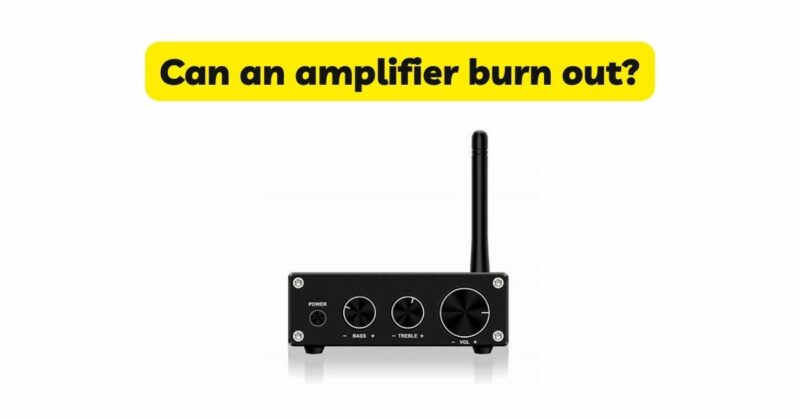The fear of amplifier burnout is a common concern among audio enthusiasts and professionals. The possibility of damaging such a critical component of an audio system can be daunting. In this article, we will explore the concept of amplifier burnout, its causes, and methods of prevention. By understanding the factors that contribute to amplifier burnout and implementing proper protection measures, audio enthusiasts can safeguard their amplifiers and enjoy optimal performance.
I. What is Amplifier Burnout?
- Definition: Amplifier burnout refers to the condition where an amplifier becomes inoperable or experiences significant performance degradation due to damage to its internal components.
- Causes: Amplifier burnout can result from various factors, including excessive heat, overloading, voltage spikes, short circuits, component failures, and improper use or handling.
II. Understanding the Causes of Amplifier Burnout:
- Excessive Heat: Heat is a primary factor contributing to amplifier burnout. When an amplifier operates at high volumes or for extended periods without adequate heat dissipation, the internal components can overheat and suffer damage.
- Overloading: Driving an amplifier beyond its rated power or impedance limits can cause stress on the components, leading to overheating, distortion, and eventually burnout.
- Voltage Spikes: Power surges or voltage spikes in the electrical supply can introduce excessive voltage into the amplifier, potentially damaging sensitive components.
- Short Circuits: Internal or external short circuits can cause an amplifier to draw excessive current, leading to overheating and component failure.
- Component Failures: Components within the amplifier, such as capacitors, transistors, or integrated circuits, can fail due to manufacturing defects, age-related deterioration, or excessive stress, resulting in burnout.
III. Prevention and Protection Measures:
- Adequate Ventilation: Proper heat management is crucial to prevent amplifier burnout. Ensure that the amplifier is placed in a well-ventilated area, away from heat sources, and with sufficient airflow. Avoid enclosing the amplifier in cabinets or stacking equipment tightly to allow for optimal heat dissipation.
- Power Conditioning: Utilize power conditioners or surge protectors to protect the amplifier from voltage spikes and electrical disturbances that can lead to damage.
- Load Matching: Match the amplifier’s power and impedance ratings to the speakers being used. Operating within the recommended limits ensures proper power delivery and reduces the risk of overloading.
- Cooling Fans: Consider using external cooling fans or fans built into the amplifier, especially for high-power or demanding applications. These fans help dissipate heat more effectively and can extend the operational lifespan of the amplifier.
- Proper Handling and Maintenance: Follow manufacturer guidelines for handling and maintenance. Avoid subjecting the amplifier to physical shocks, excessive dust accumulation, or moisture, which can lead to component failures and burnout.
- Use Reliable Power Sources: Ensure that the amplifier is connected to a stable and reliable power source, free from voltage fluctuations or irregularities. Unstable power can stress the amplifier’s components and increase the risk of burnout.
IV. Safe Operating Practices:
- Volume Control: Avoid operating the amplifier at excessively high volumes for prolonged periods. This reduces the stress on the amplifier’s components, minimizes heat generation, and lowers the risk of burnout.
- Power Cycling: Power cycling, or turning off the amplifier when not in use, can provide periods of rest for the components, reducing the risk of burnout. However, modern amplifiers are designed to handle continuous operation and may not require frequent power cycling.
V. Monitoring and Troubleshooting:
- Temperature Monitoring: Monitor the amplifier’s temperature during operation. Many amplifiers are equipped with built-in temperature sensors or indicators to warn of excessive heat. If such a feature is not available, external temperature monitoring devices can be used.
- Troubleshooting: If the amplifier exhibits signs of malfunction or unusual behavior, such as distortion, noise, or overheating, it is crucial to address the issue promptly. Consult the manufacturer’s troubleshooting guidelines or seek professional assistance to identify and rectify potential problems.
VI. Conclusion:
Amplifier burnout can be a distressing prospect for audio enthusiasts, but with proper understanding and precautionary measures, it can be mitigated. By implementing practices that focus on heat management, load matching, and power protection, the risk of amplifier burnout can be significantly reduced. Additionally, following manufacturer guidelines for handling, maintenance, and safe operating practices ensures the amplifier’s longevity and optimal performance. With diligence and care, audio enthusiasts can enjoy their amplifiers without the fear of burnout, enabling a pleasurable and uninterrupted audio experience.


